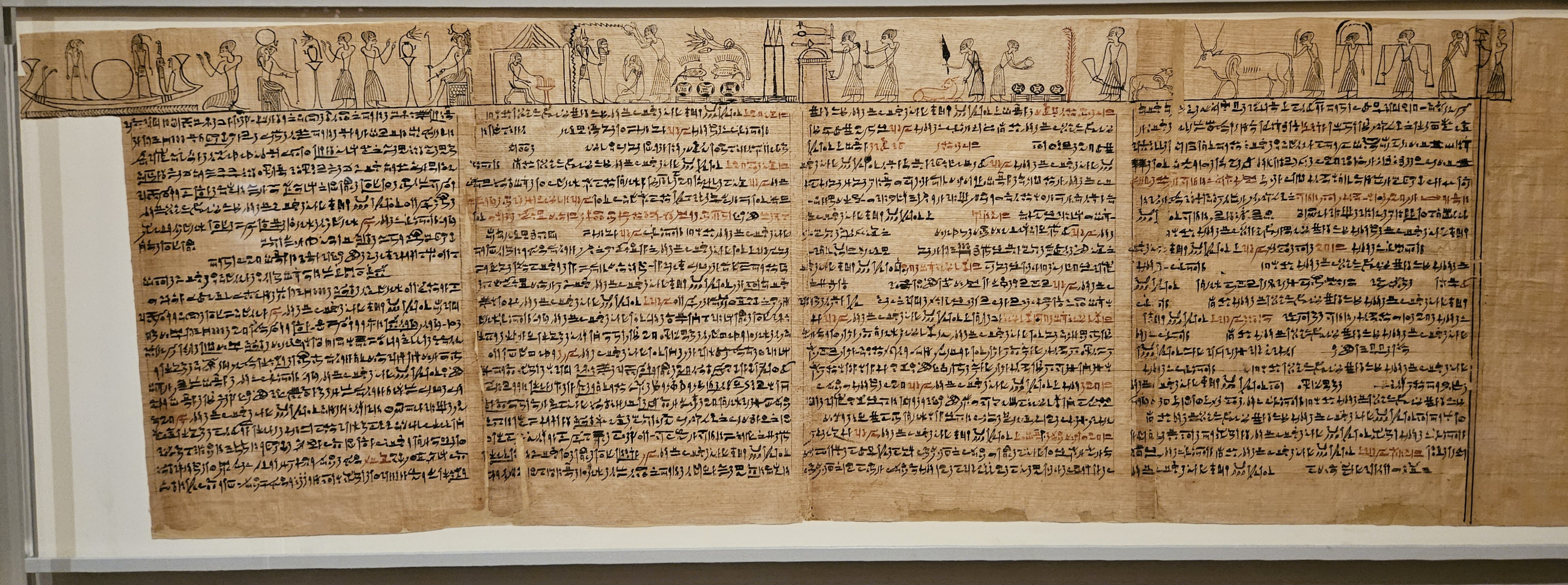
The Funeral, "Going out after going in" (Spells 1-14)
Book of the Dead of the Priest of Horus, Imhotep (Imuthes)
Early Ptolemaic Period, Egypt — c. 332-200 B.C.E.
This truly enormous papyrus scroll now dominates a full wall of the Met’s Ptolemaic display, but it was initially created to guide a priest of Horus named Imhotep to eternal life after his death.
Over 70 feet of papyrus was prepared for this grave gift, representing hours of labour in the cultivation of papyrus reeds, their harvesting, cutting, arrangement in two perpendicular layers and then the physical pummelling into a single sheet, glued in place by the natural gum of the papyrus plant, before being dried. As the average length of a single papyrus sheet was 16 inches, this scroll represents at least fifty instances of that labour, and then additional work with a starch-based adhesive, just to create the support of this text.
Atop this surface, the text and illustrations would have been created by a team of scribes using reed pens in two different coloured inks. While this particular work has not had its constituent pigments verified through spectroscopy, its historical context suggests that the inks would have been produced from charcoal and ochre. Reed pens are notable for their inflexibility - the range of line weights achieved in the illustrations of this text would have required a set of multiple tips that the artist would have had to swap out in the course of production. While the scene depicting the weighing of the heart is a dramatic and much loved episode in Ancient Egyptian depictions of the soul’s journey to the afterlife among visitors to the Met, I have chosen to highlight instead two passages from the beginning and end of this text - the depiction of the funeral rites (sections 1-14) and the spell for preservation of the corpse (151). Beyond the work required to produce this scroll, both of these segments depict the labour inherent in death in their subject matter. Notably in this text - as with ancient Egyptian funerary beliefs as a whole - the labour of preparing the deceased for the afterlife is not restricted to the mourners, but is instead a shared responsibility wherein the work, grief and love is shared between the bereaved, religious and temporal authorities, deities, and indeed the deceased themselves.
Bibliography
- Scalf, F. (2015). From the Beginning to the End: How to Generate and Transmit Funerary Texts in Ancient Egypt. Journal of Ancient Near Eastern Religions, 15(2), 202–223. https://doi.org/10.1163/15692124-12341274
- Kamrin, J. (2016). Scrolling through Imhotep's Book of the Dead. Metropolitan Museum of Art - Perspectives. https://www.metmuseum.org/perspectives/book-of-the-dead
- T. Christiansen, M. Cotte, W. de Nolf, E. Mouro, J. Reyes-Herrera, S. de Meyer, F. Vanmeert, N. Salvadó, V. Gonzalez, P.E. Lindelof, K. Mortensen, K. Ryholt, K. Janssens, & S. Larsen, Insights into the composition of ancient Egyptian red and black inks on papyri achieved by synchrotron-based microanalyses, Proc. Natl. Acad. Sci. U.S.A. 117 (45) 27825-27835, https://doi.org/10.1073/pnas.2004534117 (2020).
- ZHAKEVICH, P. (2020). Papyrus. In Scribal Tools in Ancient Israel: A Study of Biblical Hebrew Terms for Writing Materials and Implements (Vol. 9, pp. 8–44). Penn State University Press. https://doi.org/10.5325/j.ctv1bxh1j1.7